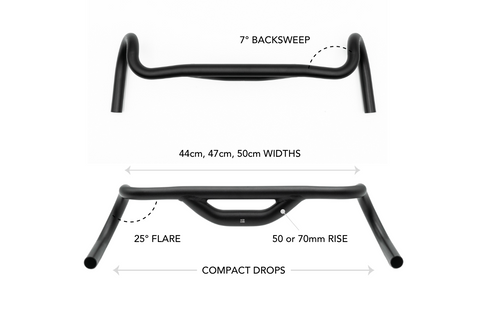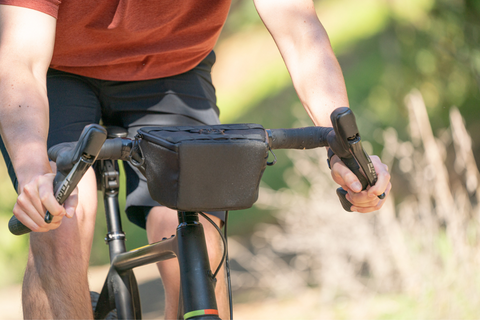The width of your bike handlebars can significantly impact your comfort, control, and overall performance, especially across different terrains like gravel, road, and mountain trails. Let's delve deeper into the intricacies of handlebar width and explore how to determine if your handlebars are too narrow for your riding needs.
Understanding Handlebar Width
Handlebar width is not a one-size-fits-all concept; it varies based on various factors such as riding discipline, body proportions, and personal preferences. Generally, flat handlebars are measured from end to end and drop bars are measured center to center across the brake hoods. Road bike handlebar width typically ranges from 38cm to 46cm, while mountain bike handlebar width falls within the range of 68cm to 82cm. Gravel bikes often feature gravel handlebars that strike a balance between road and mountain bike widths, catering to a versatile riding experience.

Negative Effects of Handlebars That Are Too Narrow or Wide:
-
Road Bikes:
Too Narrow: Narrow handlebars on road bikes can lead to discomfort and reduced stability. Riders may experience shoulder pain due to the limited space for arm movement. Additionally, narrow handlebars can compromise handling and control, especially during high-speed descents or tight turns.
Too Wide: Conversely, handlebars that are too wide on road bikes can negatively impact handlebar aerodynamics and overall riding efficiency. Wide handlebars may increase wind resistance, leading to slower speeds and increased fatigue, particularly during long rides or races.
-
Gravel Bikes:
Too Narrow: Narrow handlebars on gravel bikes can limit control and stability, especially when riding on rough or uneven terrain. Riders may struggle to maintain balance and maneuverability, increasing the risk of accidents or falls. Additionally, narrow handlebars can exacerbate hand fatigue and discomfort on longer gravel rides.
Too Wide: On the other hand, handlebars that are too wide on gravel bikes may reduce aerodynamics, so if you’re looking for a more race oriented fit, narrower bars may be a better option for you.
-
Mountain Bikes:
Too Narrow: Narrow handlebars on mountain bikes can impede handling and control, particularly on technical trails with tight turns and obstacles. Riders may struggle to navigate narrow sections of the trail or maintain stability during steep descents. Additionally, narrow handlebars can limit leverage and steering precision, affecting overall riding confidence and performance.
Too Wide: Conversely, handlebars that are too wide on mountain bikes can lead to oversteering and reduced maneuverability in tight or technical terrain. Additionally, excessively wide handlebars can strain the shoulders and arms, leading to discomfort and fatigue on longer rides.
Handlebar Flare: Bridging the Gap for Gravel Bikes
Gravel cycling presents a unique set of challenges that often require a blend of characteristics from both road and MTB setups. One key component that helps achieve this balance is handlebar flare. Handlebar flare refers to the degree to which the drops of a handlebar flare outwards from the center, providing additional leverage and control, especially on rough terrain.
For gravel bikes, handlebar flare serves as a crucial bridge between the narrower handlebars commonly found on road bikes and the wider handlebars typically used on mountain bikes. By incorporating a subtle flare, gravel bike handlebars offer riders the best of both worlds: the aerodynamics and maneuverability of narrow bars on paved roads, and the stability and control of wider bars on rough gravel.
The flare in gravel bike handlebars allows riders to adopt a more natural hand position when navigating technical terrain, providing enhanced stability and control during challenging descents or when riding over uneven surfaces. Additionally, the wider stance in the drops offers increased leverage for better handling in adverse conditions, such as loose gravel or mud.
Overall, handlebar flare plays a crucial role in optimizing the performance and versatility of gravel bikes, allowing riders to tackle a wide range of terrain with confidence and comfort. Whether cruising along smooth gravel paths or conquering rugged backcountry trails, handlebar flare ensures that gravel riders are equipped to handle whatever the road—or lack thereof—throws their way.
Redshift Sports has designed two gravel handlebars that feature 7° backsweep, 25° flare and compact drops that are ultra-comfortable for gravel riding, as well as adventure, bikepacking, road and commuting.
The Kitchen Sink gravel Handlebars are available with a traditional bar style and a loop version that provides an alternative riding position and a great place to attach gear, like our Kitchen Sink Handlebar Bag.
The Top Shelf gravel Handlebar raises your position by 50 or 70mm (2 or 2.75in) to give you an ultra-comfortable upright riding position and easy reach to the drops. It features the same backsweep, flare and compact drop as our best-selling Kitchen Sink Handlebars, so you can stay comfortable and in control no matter the terrain.
The patent-pending unique double-bar construction allows for easy, secure mounting of bags and accessories, allowing you to configure the perfect set-up for anything from an afternoon gravel adventure to an epic multi-day bikepacking trip.
Determining the Right Drop Gravel Handlebar Width

Finding the ideal handlebar width involves a combination of personal preference, body proportions, and riding style. Here are some steps to help you determine if your handlebars are the right width for your bike:
-
Shoulder Width Comparison: Stand in front of a mirror and visually assess how your shoulders align with your handlebars. For drop bar style handlebars, your handlebars should ideally match the width of your shoulders or be slightly wider, allowing for comfortable arm positioning.
-
Comfort Test: Take your bike for a ride, paying close attention to any discomfort or strain in your shoulders, neck, or hands. If you’re not comfortable with your current handlebars, consider trying wider or flared drop styles to see if they alleviate the discomfort.
- Terrain Consideration: For gravel and road cyclists who want the benefit of aerodynamics, narrower handlebars might be better for you. However, if you frequently tackle more technical terrain or prefer a more upright, comfy and high degree of control, consider wider handlebars.
- Professional Fitting: Consult with a bike fitting specialist or your local bike shop to get personalized recommendations based on your body proportions and riding goals. They can assess your riding position and suggest adjustments, including handlebar width, to optimize comfort and performance.
Adjusting Handlebar Width:
If you've determined that your handlebars are indeed too narrow or wide, here are some options for adjustment:
-
Replace the Handlebars: Invest in a new set of handlebars with a width that better suits your needs. Be sure to choose handlebars compatible with your bike's stem and other components.
-
Add Handlebar Extensions (Flat bars only): Consider adding handlebar extensions or bar ends to increase width slightly. While this won't provide a significant change, it can offer some relief for narrow handlebars or provide additional hand positions for wide handlebars.
- Experiment with Handlebar Positioning: Some handlebars allow for adjustable positioning by rotating them slightly up or down. Experiment with different angles to find a position that feels more comfortable for your shoulders and hands.
Handlebar width is a critical yet often overlooked aspect of bike fit that significantly impacts your riding experience. Hopefully these tips offer some ideas for you to find the right bars to give you balance between comfort, control, and performance for your cycling adventures.
